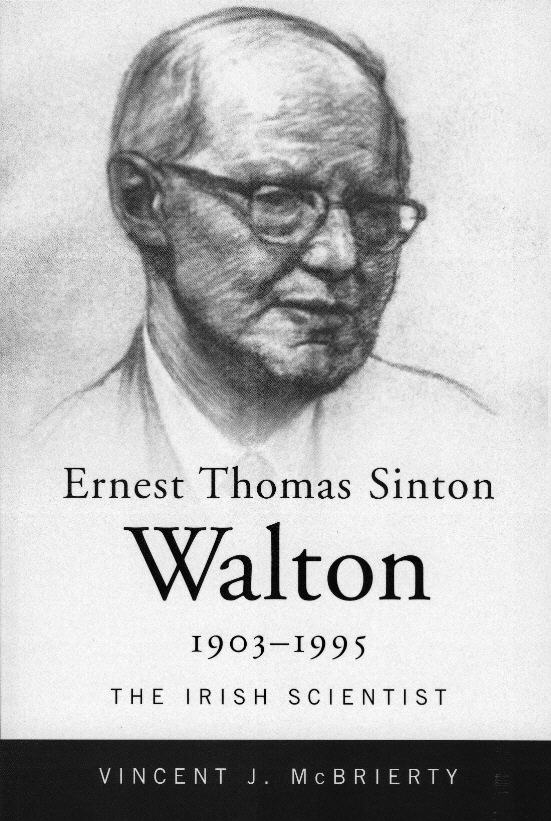Ernest Walton: an Irish Scientist
by Vincent McBrierty


Ernest Walton was one of the legendary pioneers of the twentieth century who made 1932 the annus mirabilis of experimental nuclear physics. In that year James Chadwick discovered the neutron; Carl Anderson and Seth Neddermeyer discovered the positron; Fermi articulated his theory of radioactive beta decay; and Ernest Walton and John Cockcroft split the atom (or more accurately, the nucleus) by artificial means. In their pioneering experiment. Cockcroft and Walton bombarded lithium nuclei with high energy protons linearly accelerated across a high potential difference (ca.700,000V). The subsequent disintegration of each lithium nucleus yielded two helium nuclei and excess energy of 17Mev. Their work gained them instant international recognition and the Nobel Prize in 1951.
Their experiment was important for a number of reasons: First, it pioneered a new branch of physics in which artificially accelerated particles were used to initiate nuclear interactions in a controlled way. Second, the apparatus generated fast positive ions (in this case, protons) in greater abundance than the alpha particles from available naturally occurring radioactive sources used earlier by Rutherford to achieve nuclear transmutation: the energy and flux of the proton beam were adjustable parameters. Third, the experiment verified the predictions of the new wave mechanics and validated Gamow's calculations on tunnelling based on the new wave theory. Lawrence and others apparently failed to grasp the significance of tunnelling through the repulsive barrier surrounding the nucleus in their efforts to induce nuclear reactions. And, fourth, it was the first direct experimental verification of Einstein's mass/energy relationship E=mc2 in a nuclear interaction
The centenary of Walton's birth on 6 October 2003 was a fitting occasion to reflect on the life and work of this remarkable scientist and educator.1 Born in Dungarvan, County Waterford, he received his formative education in Methodist College Belfast. After a distinguished undergraduate career in Trinity College Dublin he began his doctoral research in the Cavendish Laboratory in Cambridge in 1927 with Ernest Rutherford as his supervisor. He returned to Trinity College as a Fellow of the College in 1934 where he spent the rest of his professional life until his retirement four decades later.
Walton is remembered as a shy and impeccably modest man with unshakeable principles grounded in the Methodist tradition. Not even the Nobel Prize, the highest accolade to which every scientist aspires, diminished those admirable qualities. But those who knew Walton more intimately were aware of another side of his character, namely, a determination and tenacity to defend his deeply held principles and to promote what he considered best for his students, his staff, and society at large. It is a further measure of his humility that the full extent of his achievements was not appreciated during his lifetime, even by his closest colleagues.
Walton was renowned for the clarity of his lectures and his remarkable practical demonstrations that breathed life into Physics - a subject that often suffers from the manner in which it is taught. Outside the lecture theatre he maintained a quiet serenity and shunned the publicity that inevitably followed a Nobel Laureate. Many of his colleagues could be forgiven for thinking that his brilliance as a teacher was the sum total of his contribution to the promotion of science in Ireland.
During the war years, Walton was invited by Sir James Chadwick to join a group in the United States involved in 'war work', which later turned out to be the Manhattan Project. Although he was not particularly keen on going he nevertheless consulted the Provost who refused permission on the basis that the teaching staff in the department would be reduced to two. Contrary to general perception, Walton's decision not to participate in 'war work' was not based on inalienable pacifist principles alone. He was ever mindful of his duty to College as a Fellow and his commitment to Ireland in using his talents to alleviate, for example, energy shortages during the war years. Throughout his professional life he lectured widely on the relationship between science and religion, morality and ethics.
A careful examination of his collected papers presented to Trinity College Library after his death also revealed his unceasing efforts to promote science in the schools "sadly neglected since the foundation of the State" and to highlight at an early stage, the importance of science to the economic development of Ireland. His concern that science be used to benefit society as a whole echoed the efforts of two of his professorial predecessors in Trinity College, George Francis FitzGerald in the 1880s and John Joly in the early part of the twentieth century. In a letter written in 1957 to the Irish government he stressed the importance of a firm scientific and research foundation on which to build prosperous industries. "We are today entering a new scientific era and, if we are to benefit from it, our people should not be allowed to grow up scientifically illiterate." His masterful exposition nearly a half century ago identified at a very early stage some of the crucial preparatory steps required to compete successfully in today’s global knowledge economy: it remains a valid template for progress.
Walton's life experiences linked the remarkable advances in scientific understanding in the early decades of the twentieth century with a comparable leap forward towards the end of the century. Unrelenting new discovery and the technology that flows from it continue to transform global society and economic growth, fulfilling the visionary predictions of Walton almost a half a century earlier.
Reference
Vincent McBrierty
Professor and Fellow Emeritus,
Trinity College, Dublin.